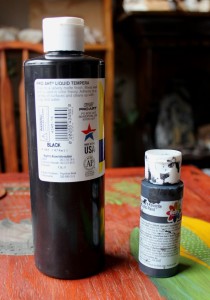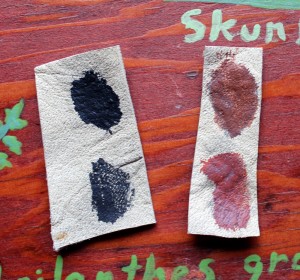Earlier this year I talked about my dislike of plastics in my art supplies, and how challenging it can be to find materials that don’t include petroleum-based synthetics. I already discussed the pros of using real fur (and, by extension, real leather) over plastic-based fake hides, and now I’d like to delve into a series of posts in which I try to find better alternatives to my usual materials.
(You can click on any of the images in this post to get bigger versions of them.)
The Contenders: Acrylic and Tempera
One of the most obvious sources of plastic in my art is acrylic paint. I use it for detailing headdresses and other hides, decorating pouches and other creations, and in my assemblage work. Acrylic paint combines pigments with an acrylic polymer emulsion, and water as the liquid vehicle. The water content allows the paint to dry much more quickly than oils, though early acrylics used mineral spirits instead of water for the same effect. As with almost all paints today, the pigments themselves are also usually synthetic or inorganic, though a few may still use organic pigments.
Since I’m a cheapskate, and I don’t actually like the thicker texture of professional-grade acrylics, I get the buck-fifty tubes of acrylic paint that are popular at craft stores. I find that the thinner texture works better for painting on leather and the like anyway; I very rarely use canvas, and even then the thicker texture still makes me unhappy. Most of my acrylics are actually secondhand; between the thrift stores and SCRAP I can get a whole rainbow of colors for way less than I’d pay new, and even if the bottles aren’t full the paint’s still perfectly usable. The only times I buy new acrylics are when I need to restock on colors I use frequently, like black, white and burnt umber, and I don’t have time to go searching through tubs and bags of secondhand bottles for the right shade.
I decided one way I could potentially cut down on my plastic consumption was by buying tempera paints, since I’d heard they had a lower plastic content. I admit I grabbed my first set of temperas on a whim when I was at Fred Meyer (a regional chain of grocery/housewares/etc. stores run by Kroger). I don’t have a Michael’s nearby, so Freddy’s little aisle of limited art supplies is my go-to for when I need something really quickly–or when I remember I need paint or glue while grocery shopping. Plus I figure a lot of people will be similarly convenience-minded, so I wanted to speak to that first before diving into slightly more obscure materials.
Fred Meyer’s only tempera option is Pro Art, a company based in Beaverton, Oregon. They have a pretty limited selection of pint volume bottles, about eight or nine in the usual primary colors, black, white, and a few others. I grabbed the black, white, green and brown since those are the colors I use the most. I had also nabbed some Pro Art copper tempera paint at Columbia Art & Drafting Supply in Portland since I couldn’t find copper acrylic anywhere (this was before I’d had the idea to test tempera paints as an alternative to acrylics). Since metallic paints sometimes behave and wear a little differently than their less sparkly companions, I figured this would be a good addition to the lineup.
Examining the Contents
 While my acrylics are from a number of manufacturers due to their primarily secondhand nature, I decided to use the bottle of black I originally bought new as the primary comparison against the black tempera. The resident acrylic brand at Freddy’s, Delta Ceramcoat, is made by Plaid, who also manufactures Apple Barrel and FolkArt, the other two commonly found “little bottle” acrylic paints. On inspecting the labels of both the bottles of black paint, I found both conform to ASTM D-4236, which means they’re “non-toxic”. All that means is they aren’t immediately poisonous if you get some on your skin or accidentally swallow some. Obviously you don’t want to drink bottles of paint or get it in your eyes, but they’re less of a problem than, say, vermilion red oil paint made with cinnabar, which contains mercury. Both are also manufactured in the U.S., always a plus in my book.
While my acrylics are from a number of manufacturers due to their primarily secondhand nature, I decided to use the bottle of black I originally bought new as the primary comparison against the black tempera. The resident acrylic brand at Freddy’s, Delta Ceramcoat, is made by Plaid, who also manufactures Apple Barrel and FolkArt, the other two commonly found “little bottle” acrylic paints. On inspecting the labels of both the bottles of black paint, I found both conform to ASTM D-4236, which means they’re “non-toxic”. All that means is they aren’t immediately poisonous if you get some on your skin or accidentally swallow some. Obviously you don’t want to drink bottles of paint or get it in your eyes, but they’re less of a problem than, say, vermilion red oil paint made with cinnabar, which contains mercury. Both are also manufactured in the U.S., always a plus in my book.
However, Pro Art’s tempera paint has something very important that Ceramcoat’s acrylic doesn’t: a list of ingredients. There are no laws requiring paint manufacturers to include ingredients on the label, but Pro Art considers it “Right to Know Information”. Brownie points to them, then! The first ingredient listed in water, unsurprisingly, and then calcium carbonate, which is the same stuff that makes up limestone, chalk, coral and the like. Then there’s “Pigments”, with the specific “P.Bk.11”, which doesn’t tell us much. Ingredient four is the one that I didn’t notice til after I’d bought the paint: a proprietary blend of acrylic thickeners. Since there are no percentages given for the amount of each ingredient, I have no way of telling whether there’s less acrylic in an ounce of this tempera paint than in my usual acrylics. And below that is a preservative labeled CAS 4080-31-3. As it turns out, that’s the code for Quaternium-15 (examethylenetetramine chloroallyl chloride), an ammonium salt containing formaldehyde, and which is a known skin irritant for some people.
Since there aren’t any ingredient lists for Ceramcoat’s acrylics, I have no idea whether it’s even more toxic. But I have to still give kudos to Pro Art for their transparency. If I’m going to switch over to them for my quick-fix paint emergencies, I do need to test their product against Ceramcoat’s.
Performance Comparison
 I used some leather scraps for testing out the paints to see which I liked better. These first three patches are just a basic test for color and coverage; the top rows on the left and right patches are acrylics, the bottom tempera. The left and center are smooth leather, the right is suede. For the piece in the center with two black streaks, the left is acrylic and the right tempera. The black and white paints are exact matches; for the brown and green I did my best to match acrylics from my existing stock to the tempera shades. Since copper is a harder color to find, I had to go with whatever was available to me.
I used some leather scraps for testing out the paints to see which I liked better. These first three patches are just a basic test for color and coverage; the top rows on the left and right patches are acrylics, the bottom tempera. The left and center are smooth leather, the right is suede. For the piece in the center with two black streaks, the left is acrylic and the right tempera. The black and white paints are exact matches; for the brown and green I did my best to match acrylics from my existing stock to the tempera shades. Since copper is a harder color to find, I had to go with whatever was available to me.
Right away I noticed the Pro Art tempera paints had a bit more body and viscosity than the acrylics, but nowhere near enough to affect their performance. They still laid down on the leather smoothly and without big clumps or ridges, and dried nice and flat. What I did notice was that, especially for the white and green, the tempera covered better with a single coat, even in the cases of the black and white paints where both the acrylics and tempera were bought brand new. This is a definite plus since the less paint I have to use, the better. And they did equally well on both smooth leather and suede.
 The one disappointment was the copper tempera paint by Pro Art. Where the other colors were vibrant and rich, and the paint coated easily, the copper was pale and the texture watery and thin. And the color was a lot less exciting compared to the copper acrylic. The pigments in the tempera were listed as “micaceous”, which leads me to believe actual mica was used in the pigmentation. This is a great idea; I think they just need to amp up the red tone in whatever their pigment mix is.
The one disappointment was the copper tempera paint by Pro Art. Where the other colors were vibrant and rich, and the paint coated easily, the copper was pale and the texture watery and thin. And the color was a lot less exciting compared to the copper acrylic. The pigments in the tempera were listed as “micaceous”, which leads me to believe actual mica was used in the pigmentation. This is a great idea; I think they just need to amp up the red tone in whatever their pigment mix is.
I found that for blending and layering, acrylics and temperas worked about the same, though since temperas are a little more viscous I found blending them to be a bit easier with the same amount of paint. Because acrylics and tempera both dry quickly and at about the same rate, any blending still needs to be done immediately. Sure, you can get slow-drying medium to add to the acrylics, but that just adds in more cost and chemical load. Since the temperas (other than the copper) are a bit thicker, you’ll need less per layer.
 As to durability? On smooth leather without sealant, acrylic holds up to being rigorously rubbed with a fingertip, while tempera wears off very quickly. However, on suede both held up just fine even without sealant. As with all painted leather, eventually both will likely crack and wear just from the movement of the leather, but with the right sealant tempera performs just as well as acrylic. The photo on the right shows unsealed black paint, an sealed brown (acrylic on top, tempera on bottom) after being distressed with a fingertip.
As to durability? On smooth leather without sealant, acrylic holds up to being rigorously rubbed with a fingertip, while tempera wears off very quickly. However, on suede both held up just fine even without sealant. As with all painted leather, eventually both will likely crack and wear just from the movement of the leather, but with the right sealant tempera performs just as well as acrylic. The photo on the right shows unsealed black paint, an sealed brown (acrylic on top, tempera on bottom) after being distressed with a fingertip.
The Verdict?
While I’m still not happy with the acrylic content and preservatives in Pro Art’s tempera paint, the fact that they disclose those ingredients is a point in their favor. Additionally, I like supporting local businesses. So for my “I need white paint NOW and it’s 10:30 at night” emergencies, I’ll run to Fred Meyer and get a bottle of Pro Art. Otherwise, I’m going to keep buying secondhand bottles of acrylics from local thrift stores, and supplement with CeramCoat when there’s a color I need a lot of and Pro Art doesn’t make it.
For my next post, I’d like to explore a different brand of tempera paint that doesn’t have any acrylic content and see how it stands up to the test. After that, there’s a package of Earth Paints sitting here waiting to be tried out. Let’s see how my attempts to reduce the plastic content in my work goes, shall we?


Very detailed post on acrylics vs tempura paints. You may be interested in our neon blacklight reactive paints. Natural and non-toxic and they wash out easily with soap an water. Many people who have skin sensitivities have used them with no problems at all.
Thank you! Awesome research.